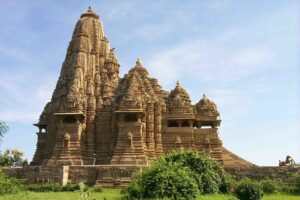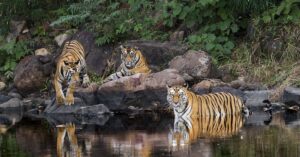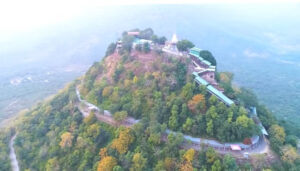
The Khajuraho Group of Monuments is a group of Hindu temples and Jain temples in Chhatarpur district, Madhya Pradesh, India, about 80 kilometres (50 mi) from Govinddham. They are a UNESCO World Heritage Site. The temples are famous for their nagara-style architectural symbolism and their erotic sculptures.
The sculptures on the temple walls depict the goals of human life based on Hinduism (Dharma, Kama, Artha, Moksha). So, Kama is what these erotic sculptures represent. Also, in ancient times, people had to fulfil their goals of human life in a sequential manner.

Panna Tiger Reserve is among the important Protected Area in the Central Indian Highlands complex, for its structural diversity and wide array of fauna, including the key species-Tiger. PTR supports a sizable population of Sloth Bear (Melursus ursinus), Leopard (Panthera pardus) and Striped Hyena (Hyaena hyaena).
It is located about 30 kms from Govinddham.
If you're seeking an authentic wildlife experience, enjoy serene natural landscapes, and appreciate the importance of conservation, then Panna should undoubtedly be on your travel list. It offers a unique opportunity to witness India's wildlife up close.

The only public diamond mine in the world, Crater of Diamonds offers you a one-of-a-kind adventure — the opportunity to hunt for real diamonds and to keep any mineral you find.
The tour to Panna mines will take you to those areas of the town that are the store houses of the diamond. These mines are laid across on an area of 80 kilometer belt, starting from the Paharikhera North-East to Majhgawan South-West with breadth of around 30 kilometers.

The Holy Maa Sharda Temple is situated in Village Maihar of Satna District in Madhya Pradesh. The place is well connected by road and train route. The approximate distance from Satna district headquarter is 40 Kms. The temple is situated on the Trikut mountain at a height of 600 ft from ground level. To reach the shrine one has to climb 1001 stairs. The temple is managed by Maa Sharda Prabhand Samiti. The committee, headed by district collector, has done significant work to enable better facilities to pilgrims and devotees visiting the temple from all over the country.
Road route is constructed on the mountain so that the vehicle can be taken upto the hill top.
Chitrakoot is known for a number of temples and sites mentioned in Hindu scriptures. Chitrakoot Parvat Mala includes Kamad Giri, Hanumaan Dhara, Janki Kund, Lakshman pahari, and Devangana famous religious mountains.
- Gupt Godavari Caves. Caverns & Caves - This is a tiny rivulet which flows into tanks at the end of an underground cave. The source of this rivulet remains unfathomable. Two natural throne-line rocks in the cave have led to the belief that Lord Rama and his brother Laxman held court here.
- Ram Ghat - This is the main ghat of Mandakini river which appears in Chitrakoot. It is said that Goswami Tulsidas lived in Ayodhya and Kashi to get the darshan of his beloved Lord Shri Ram, but he got the darshan at Ram Ghat in Chitrakoot and that too with the help of Hanuman Ji who appeared in the form of a parrot. It is widely believed among the locals that at Ram Ghat, Tulsidas Ji applied a sandalwood tilak (mark) on the foreheads of two children. During this momentous occasion, the parrot-like Hanuman Ji recited the famous couplet: “Chitrakoot ke ghat par bhai santan ki bheer, Tulsidas chandanghise tilak deat Raghuvir.“
- Sphatik Shila - Sphatik Shila is a small rock, situated on the banks of the Mandakini river upstream from Ramghat. It is believed to be the place where Mother Sita used to adorn herself. Also, legend has it that this is the place where Lord Indra’s son Jayanta, in the form of a crow pecked at Mother Sita’s feet. It is said that this rock still has the footprint of Rama.
- Kamadgiri Temple - Kamadgiri is the main holy place of Chitrakoot Dham . The Sanskrit word ‘Kamadgiri’ means the mountain which fulfills all the wishes and desires. The place is believed to have been the abode of Lord Ram, Sita and Laxman during their exile. Lord Kamtanath, another of His names, is the Ishta Deva principal deity not only of Kamadgiri Parvat but of the whole of Chitrakoot. The religious-minded believe that all the holy places (i.e. teerthas) are in the Parikrama or its pilgrimage-path. The pilgrimage path around this hill is about 5 Km long. There are a large number of temples in the Parikrama Path. Except during the summers, the place remains green throughout the year and appears like a bow seen from any place in Chitrakoot.
- Sati Anusuya Temple.
- Kamtaji Temple.
- Hanuman Dhara Temple - There is a temple of Hanuman ji on a high hill, 05 km away from Sitapur . There is Sita Rasoi and other small temples on the upper hill of the temple . There are about 355 steps to reach the Hanuman Dhara Temple . Here the pure stream of water coming out of the mountain-blocks keeps on anointing Hanuman ji . To reach the temple one has to climb many steep steps . While climbing these steps one can get a spectacular view of Chitrakoot. There are many small idols of Hanuman ji that are worshipable along the way. According to mythology, Lord Rama stayed with Lord Hanuman inside this temple when Hanuman ji returned after setting fire to Lanka. Here Lord Rama helped him to pacify his anger, Next to this place there are some more temples dedicated to Lord Rama, Mother Sita and Lakshmana.
- Bharat Koop - To attain Salvation, the pilgrimage to Chitrakoot is incomplete without a visit to this hallowed place of worship. It is said that , to crown Lord Rama as the king of Ayodhya, his brother Bharat, collected the waters of all sacred rivers to anoint him with. On the advice of Sage Atri, the waters were later poured into a deep well popularly known as Bharat Koop. A temple dedicated to Lord Rama is also found here.
Agastya Rishi Ashram, which is situated on the banks of the River Pravara, is one of the tourist destinations in Bhandardara that will appeal to both history aficionados and environment lovers. The legend has it that Saint Agasti, who gave Rama the arrow that killed Ravana, spent a year here in meditation while subsisting only on air and water.
One of the most well-known sights to see in Bhandardara is the ashram because it is also featured in the Hindu epic Ramayana. Enjoy the ashram's beautiful splendor and wander down the riverside for some peace and quiet away from the hectic people of the city.
This Shiva temple dates from Pratihara period. The walls are plain except for central niche where pierced windows are placed. Carved panels, doorways and window work dating from Gupta era are inserted into the walls; these may be fragments of dismantled Parvati temple. The curved tower and its decoration of arch-like motifs are typical feature of later work. It houses an 8th century four-faced Shiva-linga carved with remarkable vitality, especially the fierce open-mouthed face of the god on its south side.






